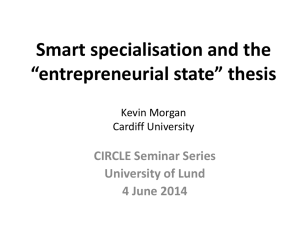Innovation Thematic Objective
advertisement
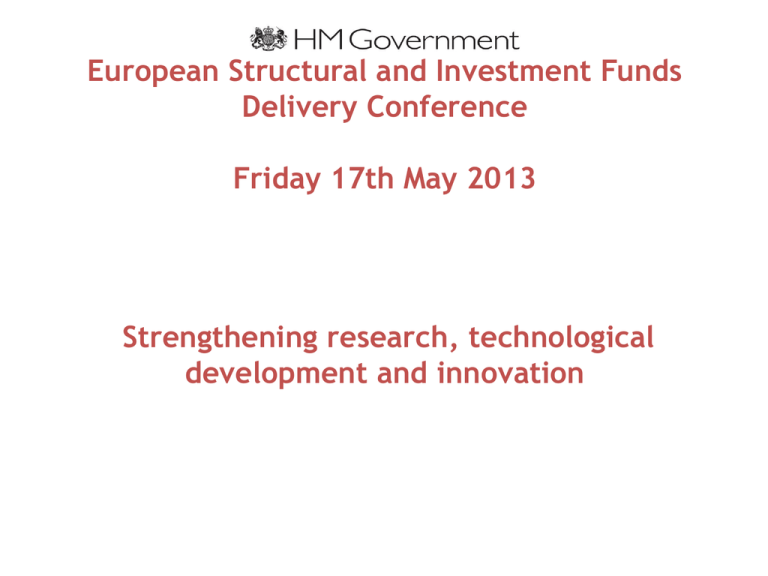
European Structural and Investment Funds Delivery Conference Friday 17th May 2013 Strengthening research, technological development and innovation Overview Strengthening research, technological development and innovation Policy context What needs to change Results & Outputs Indicators Proposed activities Match Funding LEP Sounding Board Policy Context National Innovation & Research Strategy https://www.gov.uk/government/publications/government-innovation-and-researchstrategy Industrial Strategy and 11 Sector Strategies https://www.gov.uk/government/policies/using-industrial-strategy-to-help-the-ukeconomy-and-business-compete-and-grow/supporting-pages/developing-strategicpartnerships-with-industry Eight Great Technologies https://www.gov.uk/government/news/600-million-investment-in-the-eight-greattechnologies Innovation in Health & Wellbeing https://www.gov.uk/government/policies/increasing-research-and-innovation-in-healthand-social-care#background Witty Review https://www.gov.uk/government/consultations/universities-and-growth-the-witty-reviewcall-for-evidence Atlantic Strategy & Action Plan http://ec.europa.eu/maritimeaffairs/policy/sea_basins/atlantic_ocean/ What Needs to Change? Stronger focus on commercialisation of research & development i.e. driving jobs and growth National policies & local leadership A Strategic Policy Framework for Smart Specialisation: inc. better evidence, stronger design, collaboration by geography and theme Result Indicators (1) Increased number of businesses that are actively innovating to bring new products and services to the market Increased levels of business investment in R&D and intangible assets Increased number of innovative companies that export Increased volume of R&D investment leveraged from abroad Rebalancing of the patterns of innovation across England Improving net performance on indicators of social impact through the development and wider adoption of innovative new products and services in conjunction with civil society Result Indicators (2) Extending & embedding the value chains of strategic innovation initiatives into local economies (smart specialisation indicator) Increased value of information, financial and trade flow connections between connected sectors in different places (smart specialisation indicator) Increasing the transfer of technology between related sectors, especially with the use of Key Enabling Technologies (smart specialisation indicator) Output Indicators Number of enterprises cooperating with supported research institutions (unit = enterprises) (standard) Private investment matching public support in innovation or R&D projects (unit = Euros) (standard) Number of enterprises supported to introduce new to the market products (unit -= enterprises) (higher priority) (standard) Number of enterprises supported to introduce new to the firm products (unit = enterprises) (lower priority) (standard) Number of new researchers in supported institutions helping enterprises to bring new products and services to the market (unit = researchers FTE)* (proposal to amend a standard indicator) Proposed Activities (1) Building collaborative research between enterprises, research institutions & public institutions. This can include graduate start-up schemes & support for other Higher Education Institution spin-outs delivering innovation, including social enterprises. Supporting SMEs including social enterprises to commercialise Research & Development i.e. bringing new products to the market, especially those linked to key enabling, the ‘eight great’ and health science technologies. This can include stimulating the demand for new services and products, and public procurement programmes designed to drive innovation. Physical infrastructure, including incubation space and other equipment which leads directly to the delivery of other proposed activities in this Thematic Objective. Innovation activities which contribute to low carbon goals, resource efficiency and protecting the environment, while maintaining the focus on business investment in research and innovation. Proposed Activities (2) Intermediate, technical and higher level workforce skills to support research, development and innovation. Social innovation where the project involves all the important elements of :a focus on at least one of the priority themes for social innovation; the active leadership or involvement of civil society at all stages of project design, delivery, and wider adoption; the exchange of knowledge from and to a research centre to develop, adopt and spread the use of new products and services that have demonstrable social impact; a final beneficiary that is a business or any other undertaking that acts in a business-like manner; and the intention is that the beneficiary can continue after the project is complete on a sustainable basis through the wider adoption of those new products and services . Sources of Match Funding Academic Health Science Networks HEFCE, & Research Councils (see letter) TSB (subject to Spending Review) RGF, EZ returns, TIFs, Business Rate Retention etc Universities Greater scope for private sector LEPs & Smart Specialisation No need to do a stand alone Smart Specialisation Strategy ! Use instead the RIS3 Guide (or equally rigorous)


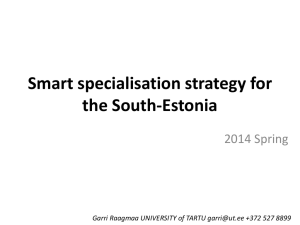

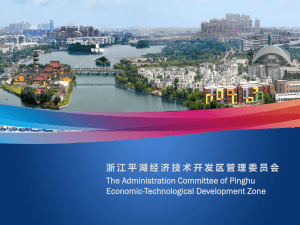

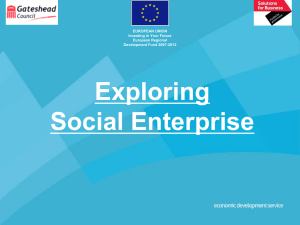
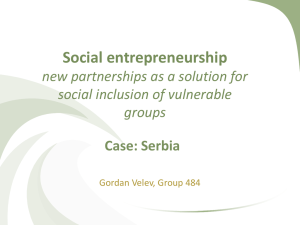
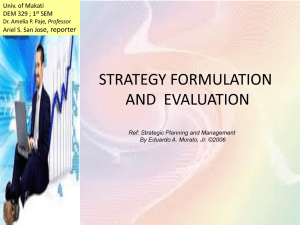
![[I-2] Mahr](http://s2.studylib.net/store/data/005533114_2-575c16bb39129d77e4fc404ccab7077e-300x300.png)

